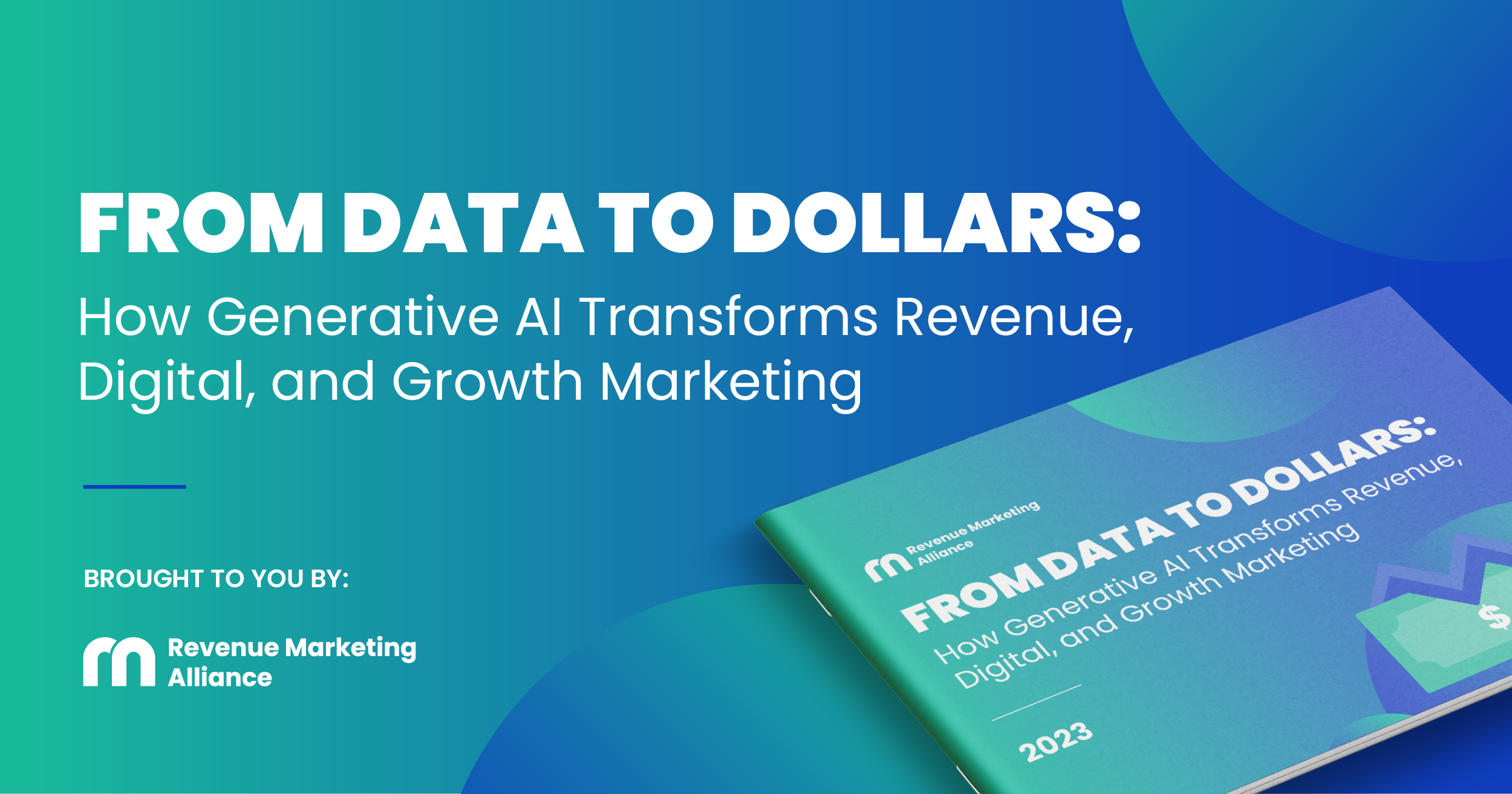This article was adapted from Tim's appearance on the Let's Talk Revenue Marketing podcast.
Going from being data-driven to data-informed has been a transformative process for both myself and the organizations I've been part of.
As someone deeply entrenched in the worlds of marketing and product development, my experiences have taught me the value of blending quantitative data with qualitative insights.
I'm Tim Cakir, CEO of TaskDrive. In this article, I’ll share insights into why adopting a data-informed mindset is crucial for businesses looking to innovate and stay ahead, drawing on examples from various industries to illustrate how this approach can unlock new opportunities and drive sustainable growth.
The journey from data-driven to data-informed
My career started in sales at a time when digital tools and social media were just beginning to emerge. I remember selling Turkish handmade luxury carpets door to door across the US, using my wit to make each sale. This experience was my first brush with the importance of understanding customer needs, albeit in a very rudimentary form.
Back then, data analytics tools were non-existent, and decisions were largely made based on intuition and direct customer interaction.
As I moved into marketing, I became fascinated by the potential of reaching people who were genuinely interested in the products I was selling. This shift led me to the UK, where I dived into digital marketing for publishing, helping magazines transition to digital platforms.
This transition was my first real interaction with data analytics, as digital platforms allowed us to track user engagement in ways that were impossible with traditional print media.
The evolution of technology introduced me to the concept of growth hacking, although I quickly learned that sustainable growth was more crucial than quick hacks. It was during this period that I began to notice the trend towards being data-driven.
Suddenly, everyone claimed to be data-driven, and it became a buzzword that was essential for securing a job in marketing. However, as I delved deeper into data-driven strategies, I realized that there might be a better approach.
I started questioning the reliance on data alone for making decisions, especially in the context of entrepreneurship and innovation. Many successful companies were founded on novel ideas that didn't have pre-existing data to support their initial decisions.
This realization led me to explore the concept of being data-informed, where data supports but does not dictate decision-making. This approach resonates with the entrepreneurial spirit, where intuition and vision play crucial roles alongside data insights.
The COVID-19 pandemic was a pivotal moment that highlighted the importance of being data-informed. During this period, despite negative trends, companies that leaned on their intuition, in conjunction with data insights, were able to make strategic decisions that contributed to their growth and sustainability.
This experience solidified my belief in the data-informed approach, especially in leadership positions where strategic decisions are crucial.
At TaskDrive I've embraced being data-informed in our operations and strategy. This approach has not only helped us navigate through challenging times but has also fostered innovation and growth within the company.
While being data-driven offers a foundation for making informed decisions, transitioning to a data-informed approach provides the flexibility to innovate and adapt in an ever-changing business landscape.
It balances data insights with intuition and vision, leading to more holistic and strategic decision-making. As we move forward, I believe that being data-informed will become increasingly important for businesses looking to thrive in the digital age.
The difference between data-driven and data-informed approaches
When exploring the practical differences between being data-driven and data-informed, I'd like to share two distinct examples that highlight the effectiveness and nuances of each approach.
COVID-19 example: Navigating through crisis with a data-informed approach
During the onset of the COVID-19 pandemic, I consulted for a CEO whose company specialized in booking services for B&Bs and small hotels. The pandemic hit the travel industry hard, leading to an immediate drop in bookings. The data-driven reaction in such a scenario would typically involve cutting costs, potentially laying off staff, and pausing operations due to the lack of bookings.
However, we chose a data-informed approach. Recognizing that hotels were empty and operators had more time to engage with new systems, we proposed to our clients that we would upgrade their booking systems for free during this downtime. This approach not only helped our clients modernize their operations but also prepared them to excel once restrictions were lifted.
As a result, when the industry began to recover, these hotels were better positioned with efficient systems, leading to a significant increase in bookings through our platform. This example illustrates how a data-informed approach, taking into account the context and forward-looking strategies, can transform a crisis into an opportunity.
Netflix example: Humanizing data with cultural insights
Another example of a data-informed approach can be seen in how Netflix curates and recommends content. A strictly data-driven approach might suggest promoting only the most popular content to maximize viewer engagement.
However, Netflix employs a data-informed strategy that incorporates cultural insights and qualitative data to tailor its recommendations to the diverse tastes of its global audience.
This strategy goes beyond mere numbers, integrating human elements such as emotions, cultural nuances, and even weather patterns to inform decision-making. For instance, on a gloomy day, a viewer might prefer content that either matches their mood or brightens it.
Netflix's recommendation engine, therefore, isn’t purely driven by viewership data but is enhanced by cultural expertise and an understanding of human psychology. This nuanced approach ensures a personalized and relevant viewer experience, showcasing the power of blending data with human insights.
These examples underline the essence of being data-informed rather than solely data-driven. It's about using data as a tool, not a dictator. In the face of complex challenges or opportunities, a data-informed approach allows for flexibility, creativity, and a deeper understanding of the human factors that influence decision-making.
Humanizing data: Beyond numbers to emotional intelligence
In our increasingly digital world, it's essential to recognize that while data provides invaluable insights, it cannot fully capture the complexities of human emotions and behaviors.
Big companies, in their quest for engagement, often leverage these emotions, which are far more nuanced than mere zeros and ones. This complexity is why artificial intelligence (AI), despite its advances, cannot replace human judgment and decision-making entirely. Humans equipped with AI tools, however, stand to redefine efficiency and innovation.

Adopting a data-informed approach means embracing a more holistic view that incorporates professional judgment, client interactions, and the human factor alongside data analytics. This methodology doesn't just rely on data but uses it as a guide to explore new ideas and validate assumptions.
It allows for flexibility and creativity, enabling individuals and businesses to experiment and learn from both successes and failures. This adaptability is crucial in a world where change is the only constant.
One of the critical aspects of being data-informed is the ability to contextualize information and ask "why" questions that data alone can’t answer. This contextual understanding fills the gaps left by raw data, integrating human intuition and knowledge to provide a more comprehensive picture.
It's also essential to acknowledge the limitations and biases inherent in data collection and analysis. Historically, biases in data have led to skewed AI models that don’t accurately reflect global diversity. Recognizing and reducing these biases is not only a technical challenge but a moral imperative to ensure that AI and data analytics serve all of humanity equitably.
The path forward involves making AI and data technologies more accessible and representative of global diversity. By democratizing these tools and encouraging contributions from various cultures and societies, we can work towards a future where data and AI are inclusive and reflective of the rich tapestry of human experience.

This inclusivity is vital for developing technologies that understand and cater to the needs of people from all walks of life, fostering a world where data not only informs but also enriches our lives.
The role of cultural sensitivity and strategic vision in data utilization
In an era where data is often considered the gold standard for decision-making, it's vital to remember that data alone can lead to missed opportunities, especially when cultural sensitivity and strategic vision are sidelined.
Platforms like LinkedIn, while invaluable for B2B marketers in many regions, may not hold the same relevance in parts of Asia where different professional networking habits prevail. This example underscores the importance of understanding and respecting cultural differences in data collection and analysis, ensuring that businesses do not overlook potential markets due to a lack of localized data.
Adopting a data-informed approach allows companies to complement their vision and strategy more effectively. Being solely data-driven can sometimes lead to short-term decision-making that might deviate from a company's long-term objectives and values.
For instance, adverse data trends in the short term shouldn’t deter a company from pursuing its mission, especially if its leaders believe in the potential for future success. It's about guiding the data to serve your strategic goals, not letting transient data points derail your core mission.
History has shown that the most successful businesses often make key decisions before the data fully supports those moves. This proactivity, especially in times of rapid market changes like the COVID-19 pandemic, requires a blend of data insight and human intuition.
Great leaders and decision-makers don’t rely solely on data but also consider socio-political events, emotional responses, and personal intuition when making decisions. This approach ensures that businesses remain agile, responsive, and aligned with their fundamental values and objectives, even in the face of uncertainty.

Ultimately, a data-informed approach respects the complexity and richness of human judgment. It acknowledges that while data can illuminate paths and possibilities, the human capacity to interpret, understand, and act upon that data in context is irreplaceable.
In recognizing the limitations and biases of data, and integrating it with our unique human insights and experiences, we can make decisions that’re not only informed by data but also enriched by the depth of our understanding and the breadth of our vision. This balanced approach ensures that we remain truly connected to the people and world we aim to serve, making decisions that’re as compassionate and nuanced as they’re data-informed.
Embracing a data-informed approach for long-term success
The journey toward becoming truly data-informed involves recognizing the limitations and imperfections inherent in data sets. By critically analyzing data while understanding that it may not be complete, businesses can make more nuanced decisions.
This approach is crucial, especially as we now live in a world inundated with data, where the temptation is to measure and analyze everything. However, discernment is key; not all data should dictate our actions, particularly when it comes to personal well-being and professional strategies.
One of the significant challenges is the overemphasis on quantitative data at the expense of qualitative insights. While quantitative data can guide many decisions, qualitative data brings depth and understanding to those decisions, offering insights into customer preferences, employee satisfaction, and market dynamics that numbers alone can’t provide.
For instance, choosing to retain a feature used by a minority of clients because it's valued highly by them demonstrates a perceptive, customer-centric approach that quantitative data might overlook.
A data-informed approach allows you to remain flexible and aligned with your long-term vision and strategy. This flexibility means sometimes going against the immediate suggestions of data to stay true to the company's mission or to seize long-term opportunities that current data doesn't fully support.
It also underscores the importance of being proactive and making decisions based on a blend of data, intuition, and strategic goals, especially during rapid market changes.
Data should be a tool for exploration and innovation, not a constraint. A purely data-driven mindset might discourage risk-taking and innovation because it focuses on optimizing what works now rather than what could work in the future.
Empowering employees to make decisions based on their expertise and insights, alongside data, cultivates a sense of ownership and responsibility. Acknowledging that not all decisions will be correct, but learning from those that aren't, is a critical component of a data-informed culture.
Keeping a decision-making journal or error log can help document the rationale behind decisions and their outcomes, providing valuable lessons for future decision-making processes.
The essence of a data-informed approach lies in its recognition of the complexity of decision-making, where data is one of many inputs into a process that also values human judgment, intuition, and strategic vision.
By embracing both quantitative and qualitative insights and maintaining a flexible, forward-looking perspective, you can navigate the challenges of a rapidly changing world with confidence and creativity.
Navigating data in organizations: A mixed approach
When it comes to organizational decision-making, the distinction between being data-driven and data-informed isn’t just a philosophical debate but a strategic necessity.
While predictive analytics and AI have significantly enhanced our ability to make data-driven decisions, the essence of leadership, innovation, and strategic foresight often relies on a more data-informed approach. This approach acknowledges the limitations of data, appreciating that it represents historical patterns that may not fully encapsulate future possibilities or the depth of human experience.
The question of whether individuals or teams within an organization should adopt a data-driven or data-informed approach is nuanced. It suggests a mixed strategy, where the nature of the work dictates the approach.
Technical teams like IT and development, might lean more towards a data-driven approach, valuing precision, efficiency, and clear metrics. While, product teams, marketing, and leadership might benefit from a data-informed perspective, allowing room for creativity, intuition, and strategic flexibility.
Data-driven vs. data-informed roles
- Development and IT teams: Favor a data-driven approach for its emphasis on precision and efficiency, crucial in coding and technical problem-solving.
- Product teams: Thrive on a data-informed approach, blending data with creativity and user experience insights to innovate and enhance product design.
- Sales and marketing teams: While CRM systems and sales metrics might lean towards a more data-driven approach, the overall strategy in marketing often benefits from being data-informed, acknowledging the importance of brand perception, customer experience, and market trends that’re not easily quantifiable.

- Leadership: Executives, especially CEOs, should embody a data-informed approach, balancing the wealth of data available with vision, intuition, and the human elements of leadership that drive a company forward.
The dialogue underscores the effectiveness of integrating sales and marketing into a unified growth or revenue team, advocating for a balanced approach that leverages both data-driven efficiency and data-informed creativity.
This integrated approach facilitates better alignment of goals, strategies, and a shared understanding of success metrics, enhancing the organization's ability to adapt and thrive in a competitive environment.
Final thoughts
The distinction between being data-driven and data-informed within an organization isn’t binary, it’s a spectrum, where different roles may lean toward one approach over the other based on their specific functions and objectives.
A mature organization recognizes the value in both approaches and seeks to harmonize them across teams, fostering an environment where data serves not just as a source of insight but as a springboard for innovation, strategic decision-making, and sustained growth.


